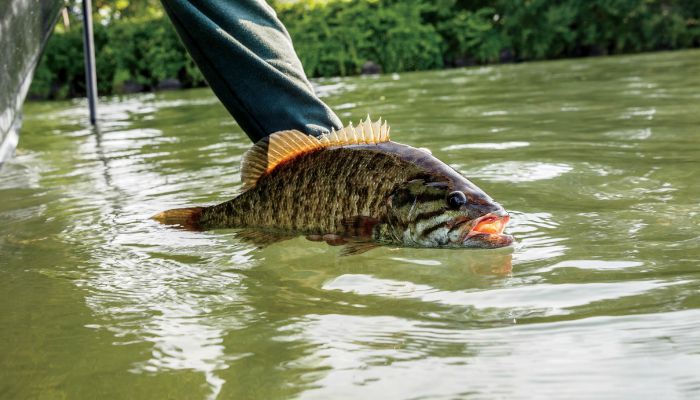
When the sun bears down relentlessly, few types of fishing offer more soothing relief than casting to river smallmouth. You can use a canoe or johnboat to get into fresh, untapped stretches, but plan on wet wading at least part of the day to keep the heat at bay.
A modest selection of lures will serve you well on smallmouth water throughout the country, anywhere from the Susquehanna in Pennsylvania to the Snake in Idaho. But it’s important to customize the offerings to suit the low river levels and glassy water typical of summer and early fall. Thick monofilament and large lures might have worked in the spring, but now it’s time for 4- to 6- pound line, light rods, and down-sized baits.

Start From the Top
Bronzebacks often feed on top when water temps are high—chasing damsel and dragonflies, nabbing grasshoppers, sipping in large mayflies, and slashing at baitfish. You don’t have to “match the hatch” for smallmouth, but simply find out if the fish are in the mood for topwater, and then present them with one of a few favorite offerings.
Two top picks include a prop lure such as a Heddon Tiny Torpedo or a stickbait like a small Zara Puppy. Poppers sometimes work, too, and a small black Jitterbug can be deadly at night.
Soft plastic jerkbaits work great for summer and fall smallies because of their erratic, life-like motion and pliable feel once a fish grabs them. Try them on top first, twitching and darting the lure chaotically like a minnow in its death throes. Pause next to rocks, ledges, or logjams so the lure sinks briefly. If this doesn’t produce, try the same tactic a few feet below the surface.
Crank ‘Em In
If you want to go a bit lower in the water column—bridging the gap between surface and shallow—try thin minnow plugs such as the Rapala Floating Minnow. Cast to prime targets and twitch the lure gently, then let it rest. Twitch it again and wait. A slamming strike is likely. If that doesn’t produce, reel back slow and steady.
You can also try small versions of the same lures you use for largemouth, as well as the mini-crankbaits made by Rebel and Yo-Zuri. Stock a few that specifically imitate crayfish—a prime smallmouth food. Probe deeper pools, runs, undercut banks, and ledges, bouncing the lures off rocks and logs to draw instinct-strikes from bass waiting in ambush.
Downsize Soft Plastics
When smallmouth are hovering on or near the river bed, few lures can top a soft plastics rigged with enough weight to crawl over the rocks and ledges.
Grubs work best of all. Rig them on a 1/16- to 1/8-ounce round jighead or Carolina-style on a size 4-8 hook, 18- to 24-inches behind a split shot and swivel. Top colors include pumpkinseed, smoke, watermelon, motor oil, and chartreuse.
Four-inch plastic worms are another great choice. Rigged them Texas-style or with multiple exposed hooks if snags aren’t a problem.
Focus on Key Cover
River smallmouth often seem to be everywhere, but you’ll draw more strikes and bigger fish by concentrating on certain types of cover during summer and early fall. Don’t miss a chance to fish undercut banks, fallen trees, weed beds, deep holes, and eddies. Also be on the watch for fish swirling. It could be a single bass nabbing a shiner or a school of three-pounders waiting to do battle.
Planning to pursue smallmouth in your local lake? Don't forget The 5 Lures Smallmouth Can't Resist.
- 51152 views

